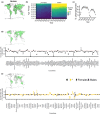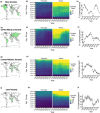The impact of macroeconomic factors on suicide in 175 countries over 27 years
- PMID: 34032310
- PMCID: PMC9292781
- DOI: 10.1111/sltb.12773
The impact of macroeconomic factors on suicide in 175 countries over 27 years
Abstract
Background: Every year, more than 800,000 people die by suicide, three-quarters of which are males. Economic factors influence suicide rates, but a worldwide perspective of their impact according to age and sex is lacking.
Method: We queried publicly available datasets on economic factors and on suicide rates stratified according to sex and age, from 1991 to 2017, for 175 countries. Thus, we analyzed approximately 21 million deaths by suicide using a multivariable regression model approach.
Results: Every 1% increase in global unemployment rates is associated with a 1% upsurge in male deaths by suicide (Relative risk (RR) = 1.01 [CI 95% 1.00-1.01] with respect to females) or 5000 excess male deaths. A 1% higher unemployment rate also exerts age-specific effects on suicide rates, since, among adults aged 30-59, the suicide rate is increased by 2-3%. Lastly, for every 1000 US dollar increase in the GDP per capita, suicide rates are reduced by 2% (RR = 0.98 [0.98-0.98]), corresponding to a reduction of 14,000-15,000 suicide deaths per year globally.
Conclusions: Males who have lost their jobs in adulthood are those at higher risk of suicide and to whom financial support measures should be delivered in a timely manner.
© 2021 The Authors. Suicide and Life-Threatening Behavior published by Wiley Periodicals LLC on behalf of American Association of Suicidology.
Conflict of interest statement
None.
Figures


Similar articles
-
Modelling suicide and unemployment: a longitudinal analysis covering 63 countries, 2000-11.Lancet Psychiatry. 2015 Mar;2(3):239-45. doi: 10.1016/S2215-0366(14)00118-7. Epub 2015 Feb 25. Lancet Psychiatry. 2015. PMID: 26359902
-
Analysing regional unemployment rates, GDP per capita and financial support for regional suicide prevention programme on suicide mortality in Japan using governmental statistical data.BMJ Open. 2020 Aug 27;10(8):e037537. doi: 10.1136/bmjopen-2020-037537. BMJ Open. 2020. PMID: 32859665 Free PMC article.
-
Suicide rates in Iceland before and after the 2008 Global Recession: a nationwide population-based study.Eur J Public Health. 2020 Dec 11;30(6):1102-1108. doi: 10.1093/eurpub/ckaa121. Eur J Public Health. 2020. PMID: 32789460
-
Economic recession and suicidal behaviour: Possible mechanisms and ameliorating factors.Int J Soc Psychiatry. 2015 Feb;61(1):73-81. doi: 10.1177/0020764014536545. Epub 2014 Jun 4. Int J Soc Psychiatry. 2015. PMID: 24903684 Review.
-
Cause and effect in studies on unemployment, mental health and suicide: a meta-analytic and conceptual review.Psychol Med. 2014 Apr;44(5):909-17. doi: 10.1017/S0033291713001621. Epub 2013 Jul 9. Psychol Med. 2014. PMID: 23834819 Review.
Cited by
-
Integrative Analyses of scRNA-seq, Bulk mRNA-seq, and DNA Methylation Profiling in Depressed Suicide Brain Tissues.Int J Neuropsychopharmacol. 2023 Dec 18;26(12):840-855. doi: 10.1093/ijnp/pyad057. Int J Neuropsychopharmacol. 2023. PMID: 37774423 Free PMC article.
-
The Role of Unemployment, Financial Hardship, and Economic Recession on Suicidal Behaviors and Interventions to Mitigate Their Impact: A Review.Front Public Health. 2022 Jul 6;10:907052. doi: 10.3389/fpubh.2022.907052. eCollection 2022. Front Public Health. 2022. PMID: 35875017 Free PMC article. Review.
-
Can role model women in politics help married women reduce suicides? Evidence from a quasi-experimental study in Brazil.Front Public Health. 2025 Jan 10;12:1513669. doi: 10.3389/fpubh.2024.1513669. eCollection 2024. Front Public Health. 2025. PMID: 39872104 Free PMC article.
-
Public mental health stigma and suicide rates across Europe.Front Public Health. 2025 Jun 3;13:1554072. doi: 10.3389/fpubh.2025.1554072. eCollection 2025. Front Public Health. 2025. PMID: 40567950 Free PMC article.
-
The association between nation-level social and economic indices and suicide rates: A pilot study.Front Sociol. 2023 Mar 31;8:1123284. doi: 10.3389/fsoc.2023.1123284. eCollection 2023. Front Sociol. 2023. PMID: 37066069 Free PMC article.
References
-
- Ásgeirsdóttir, H. G. , Valdimarsdóttir, U. A. , Nyberg, U. , Lund, S. H. , Tomasson, G. , Þorsteinsdóttir, Þ. K. , Ásgeirsdóttir, T. L. , & Hauksdóttir, A. (2020). Suicide rates in Iceland before and after the 2008 Global Recession: A nationwide population‐based study. European Journal of Public Health, 30, 1102–1108. 10.1093/eurpub/ckaa121 - DOI - PubMed
-
- Askitas, N. , & Zimmermann, K. F. (2009). Google econometrics and unemployment forecasting. SSRN Electronic Journal, 10.2139/ssrn.1480251 - DOI
-
- Basta, M. , Vgontzas, A. , Kastanaki, A. , Michalodimitrakis, M. , Kanaki, K. , Koutra, K. , Anastasaki, M. , & Simos, P. (2018). Suicide rates in Crete, Greece during the economic crisis: The effect of age, gender, unemployment and mental health service provision. BMC Psychiatry, 18(1), 356. 10.1186/s12888-018-1931-4 - DOI - PMC - PubMed
Publication types
MeSH terms
LinkOut - more resources
Full Text Sources
Other Literature Sources
Medical

